| POST PUNK PINK |
|
|
|
Paul VANDENBROECK1 |
|
‘Tachism’, ‘abstract expressionism’, or the like, are by no means a Western modernist invention. The ‘feminine’ art of weaving explored these principles prominently --and much earlier than Western artists. Let us turn to North Africa and to Iran. We refer primarily to textiles created for domestic use, rather than commercialized fabrics. Here the unpredictable and ‘chaotic’ configurations are presented without any reference to the visually discernible world. Such compositions are particularly prominent in Iranian and North African weaving. In the so-called ‘free style’ of North African weaves, the configurations appear as nameless. Fieldwork has made clear that these shapes or formations are often felt to be allusions to the (pro)creative process. The most characteristic and at the same time most puzzling works in the ‘spontaneous’ style are a number of carpets without leitmotif and without over-all pattern. The surface is covered with unrecognizable shapes that merge into one another, ‘channels’ that get wider and narrower, ‘flashes of lightning’ that flare up in feverish zigzags, ‘veins’ that change colour, narrowings and broadenings in which ‘something’ seems to take shape that at closer inspection is entirely unrecognizable – and carries on along its own way. There is not the slightest hint of figuration or representation. These compositions remain nameless. Fieldwork that we have carried out in Morocco and Tunesia indicates that they are sometimes referred to as dou- or bouwakhkhiya (‘with dizziness’), moulli (see below), moufassal (‘telling’, ‘shaping’) or khoumiya (‘fermentation’). The first of these appellations refers particularly to the eye-dazzling compositions, the others to the less dazzling, but highly idiosyncratic weaves. |
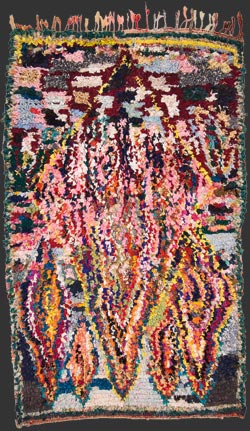 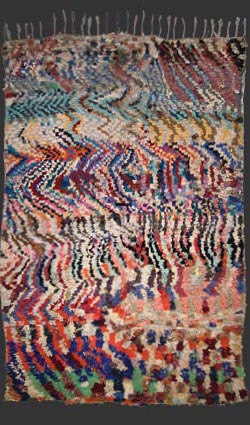 |
| boucherouite, 240 x 150 cm (8' x 5') boucherouite, 210 x 160 cm (7' x 5' 4'') |
| A number of carpets from the Middle Atlas and Southern Morocco are made up entirely of ‘lightning’ patterned in irregular flashes across the field. In other cases the zigzags show some regularity. A kilim woven in the Tunisian steppe near El Regeyeb is entirely covered in a furious zigzag in alternating colours.2 It almost seems to be prefigured by a field of concentric lozenges in irregular zigzag lines on a Tunisian-Roman mosaic from the 2nd or 3rd century.3 |
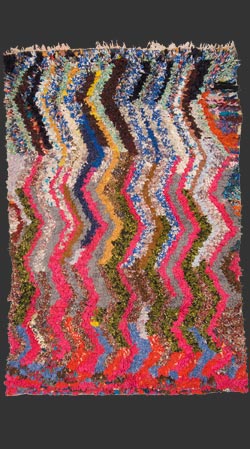 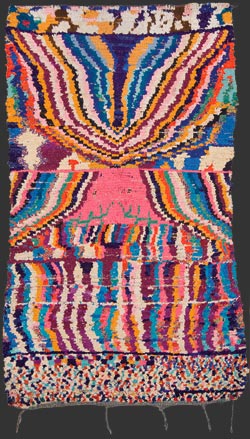 |
| boucherouite, 200 x 140 cm (6' 8'' x 4' 8'') boucherouite, 180 x 115 cm (6' x 3' 10'') |
|
In other weaves the zigzags follow untraceable patterns that flash away like an electrical discharge.4 Several of these weaves have patterns identical to those found in the mosaics of the Roman period. A pattern of a field of concentric lozenges, built up out of blocks and giving a ‘teeming’ impression,5 can be seen both on Tunisian kilims and on a mosaic from Utica.6 A tight composition of entirely regular rectangles can be found both in the latter location, and in carpets from the area of Oulmes in Morocco. Then there are the extremely repetitive compositions that confuse the gaze and therefore function as a means of defence from the ‘evil eye’. Sometimes small white stones are embedded in a dark background at irregular distances,7 as in some knotted carpets from the Middle Atlas; sometimes completely chaotic light spots are used on a dark field.8 In the Mediterranean area materials or objects with inextricable patterns – a field of spots, unrecognizable shapes or complicated patterns of lines – were greatly favoured for their apotropaic effectiveness.9 Belief in their protective powers in large part explains the remarkable preference for ‘decorative’ woven, plaited, intertwined patterns. This is true of all woven, knitted, crocheted, knotted materials, but also of plants, trees or arbours, that are trained into inextricable wholes.10 The dizzying effect of the line on a number of Berber weaves is similarly intended to ward off the ‘evil eye’. A labyrinthine structure,11 a confusing network, or an indeterminate representation12 had the same protective effects. Since ancient times, strong apotropaic effects have been ascribed to unclear, mazelike, elusive interconnections.13 Yet warding off the evil eye, if this was among the weaver’s intentions, is far from the only purpose of these weaves. The few indications that we have, suggest that there is much more behind this ‘chaotic’ iconography. In Morocco, the weaves of the ‘first style’ are primarily found in the Rehamna tribes from the steppe above Marrakech (one of the most inhospitable landscapes in the country), but also in the region of Bouja‘d or Azilal, or in eastern Morocco among the Aït Bou Ichaouen.14 They often look very ‘chaotic’. In rare cases this may be the result of compositional incompetence, in other cases it is the result of the deliberate attainment of a desired outcome. The archaic-rural worldview is often wrongly seen as clear and unchanging. While it does have those qualities, it is in constant motion and flux. The Greek philosopher’s panta rhei (‘everything flows’) summarizes a very old cosmology. The worldviews of male learning have always tried to elicit an order and a pattern that would make things in themselves, and the relationships between them, clear and comprehensible. There was no room here for the material-bodily processes of eating, excretion and sexuality. And the body is never static: it grows, gets stronger, gets weaker, falls ill, is internally in constant motion. The ‘popular’ system never lost contact with the ‘lower’ everyday realities, and saw the world itself as a living organism.15 For the social body is similar to the physical body in the mutual interaction of its members and the building of a habitation. |
| ‘Moulli’ and the energetics of nature |
|
The same ideas regarding the functioning of an organism were – unconsciously — also applied to agricultural systems of irrigation. An irrigation network seems a prime example of a rational system with a purely practical end. Yet its building and the ‘stories’ surrounding it provide an example of ‘indwelling’. This is dual: on the one hand the way in which the participants in the social event see their own experience, and on the other, how they regard a technical system as a living organism. Central to the vocabulary connected to irrigation networks are the words rabta and mafsal. Rabta derives from the root r-b-t, ‘bind’, ‘connect’, ‘reinforce’, and means something like ‘bond’. The word carries connotations of ‘knotting’ and ‘fastening’. Mafsal derives from the root f-s-l, ‘split, separate, wean, abandon’; second stem ‘divide into pieces’; third stem ‘untie, loosen’. Fasl means ‘separation, division’, and also ‘joint, season of the year’; faysal is ‘judgement, decision’. The basic meaning of f-s-l is therefore division, loosing, in a literal and a figurative sense, and relates to elements found in the body, such as the ‘joints’ (mafsil).16 This sheds light on the meaning of tafsil and moufassal: ‘narration’, ‘detailed account’, and mifsal, ‘language’. Rabta and mafsal both refer to an articulation, a division/connection; they bring to mind a hinge that both opens and closes. Both terms denote unity through separation, a boundary that separates two elements but at the same time, through its own position, links them together. In an irrigation network a rabta is a temporary mud dam in a channel, opened at fixed times to make it possible for the water to flow through. The rabta ‘collects’ the flowing water, making it ‘swell’ and bubble by canalizing its energy. In doing so it creates rouh, bringing about life as though organically. The rouh is not a property of flowing water, but of water that has been led into a new channel. Rouh arises from an ‘in-between’, something that is neither flowing nor standing. Something that did not before exist is ‘born’. Like an oasis, the body is a collection of opening/closing articulations (mfasil) and hydraulic circuits. That division and unity were closely linked in traditional Berber culture (as in the moulli), is also apparent from the language. The root b-l-g or b-l-gh denotes ‘dividing in two’, ‘separating out’, but also ‘holding in common’, ‘uniting’, ‘joining together’ (as in the Arabic w-l-a, whence moulli), as well as ‘to become heated, to burst out’.17 In Berber, the root b-d refers to a narrow passage, a channel (for irrigation), a penetration (whence ebed, ‘deflower’ and ‘dig a well’), and a hole. Verbs deriving from this root have to do with various senses of ‘division’: to separate, to divide, to share out, to share with, and to irrigate.18 Other nouns from this root refer to the ‘bottom’, the root, the anus, the stem, the navel (or the umbilical cord), a swelling. The range of meanings of the Berber b-d is roughly the same as that of the Arabic r-b-t. The understanding of the living body is apparent from these concepts: it is not a static whole, nor is it a machine (as modern culture imagined it), but it is subject to continual reshaping and inner motion. This is the meaning of the term moulli, from the root w-l-a. The root means ‘to be close’ (and ‘to be friends with’; hence wali, ‘saint’: somebody close to God, a friend of God). The second form, walla’a, means the opposite: ‘to turn away from, to turn, to flee’; the third form (waala’a) ‘to continue’ and ‘to make an alliance’; while the fourth form (awla’a) means ‘to approach’. The connotations of w-l-a are in the lexical field of ‘closeness’ but also of its opposite: ‘to remove oneself, to turn away’. The root moulli furthermore carries meanings of ‘to be master of, to rule’. Moulli therefore connects the opposite conditions of ‘closeness’ and ‘removal’ (as rabta and mafsal indicate the function of articulation). Moulli refers to back and forth, approach and regress, in this case according to the articulations of the irrigation network or of the community. It is a motion that mobilizes the potential of an organism, its rouh or life force, so that it can do its work and return to a state of repose. |
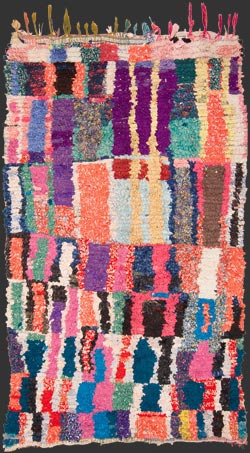 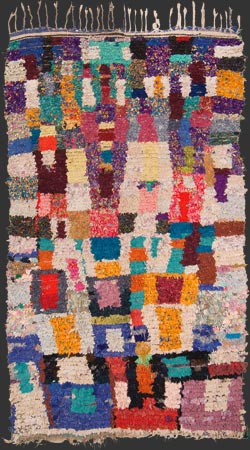 |
| boucherouite, 200 x 120 cm (6' 8'' x 4') boucherouite, 200 x 120 cm (6' 8'' x 4') |
| . . . and the powers of the uterus. |
|
The endless shades between formlessness and form in Berber textiles are analogous to the sense of the formation of the child in the womb. The Qur’an formulates this as follows (Sura 22:5): ‘we (sc. Allah) created you from earth, then from a clot, then from congealed blood, then from a morsel, shaped or shapeless.’ Pregnancy is seen as analogous to the making of cheese, the baking of bread, and to processes of fermentation, decay, heating, continual modification and gradual formation.19 The Jewish folktale of the golem arises from just such a feeling (golem means ‘formless fruit’ or ‘unfinished pot’). In North African folk culture pregnancy is seen in the same way. To grasp what occurs during pregnancy,20 Moroccan women use the metaphor of water, as in the oasis culture. The water in the irrigation channels is pure, but does not of itself bring forth life. So too the sand: it is ‘white’ and pure, but left to itself also ‘dry’, sterile. Water has to be diverted, dammed, and channelled into a field, in order to bring forth life. Standing water mixes with mud and leaves, and yeast. It now gives off a smell, and becomes ‘black’. After water has stood for a while, little creatures can be seen in it that were not present when it was flowing.21 |
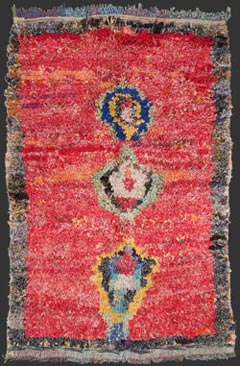 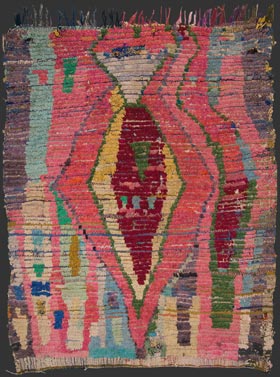 |
| boucherouite, 170x115 cm (5' 8'' x 3' 10'') boucherouite, 190x165 cm (6' 4'' x 5' 6'') |
|
Fermentation in ‘black’ water creates life.22 This is what happens during pregnancy. The ‘pure’, ‘white’ ‘water’ of the man is captured and contaminated, but can only then create new life. It coagulates into a formless lump. In the first months of pregnancy a woman has a smell, and her complexion darkens. Often she avoids others, sleeps in dark corners, preferably on a mat woven from goat hair. Her womb, they say, contains ‘something that ferments’ (kh-m-r). The root kha-ma-ra refers to covering, wrapping, hiding, holding back, blushing, and fermenting. The fourth stem also refers to mental images, daydreams, ruminations, entering into. The fifth stem means being veiled (for women), fermenting, changing inwardly. Khamar is what withdraws from view, khimar is the veil, khoumra is yeast or the scent with which one is permeated. Covering the head therefore has something to do with screening the female power of procreation, and more particularly with its darkest and most secret aspect.23 During pregnancy, the womb or the belly is ‘seen’ as a fermentation vessel, with shapeless contents. People speak of ‘rotting’, in line with a pregnant woman’s unpredictable whims and cravings often for inedible substances. The shapeless processes in he body are ‘dirty’ and reminiscent of death (by analogy with decomposition), but this morbid aspect carries new life within it. In traditional society, pregnancy is a woman’s time of power, when she can demand anything, even if it is contrary to the otherwise inviolable division of roles between man and woman. The first months of the pregnancy are the time of touhim, ‘desire’. Her body is now doing the impossible. From ‘rotting’ chaos it is creating form, like curds and butter in milk. This comparison may sound disrespectful to Western readers, but the analogy between creation and pregnancy, and what happens to fermenting yeast or curdling milk, is crucial to a very old and rural worldview and image of humanity. The ‘rotting’ shapelessness is here no decline into decomposition, but fermentation into form. A differentiation begins to take shape. Something begins to delineate itself (fasl), to gather in, to contract (jm’). Azrael, the angel of death, sows in the womb dust from the tomb of the person-to-be. This soil sets the shaping-from-shapelessness in motion. The process is symbolized by the foetus’s hands: from an undifferentiated lump, fingers branch off (in Berber weaving the hand is an important motif of protection, but also of becoming). From the phase of the foetus’s definitive articulation the mother enters a ‘white’ cycle, not completely ‘white’ but still grappling with the ‘black’. |
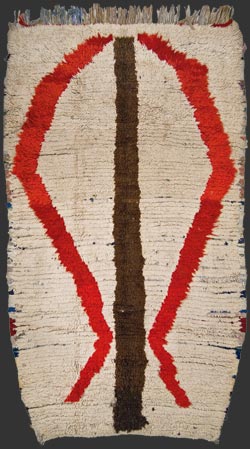 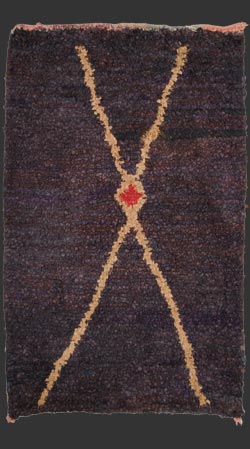 |
| boucherouite, 250 x 140 cm (8' 4'' x 4' 8'') boucherouite, 185 x 120 cm (6' 2'' x 4') |
|
One should avoid too simplistic a reading of this mythology of black-and-white. ‘White’ is not the same as ‘life’, nor is ‘black’ to be identified with ‘death’ – as has been common in the Western tradition. Both states are continually mixing together. White is inhabited by black and vice versa. In the countless and fluctuating ‘seams’ between the two, life is born and flows on. White tends to dryness and to sterility,24 so is also a form of death. Black tends to wetness and fertility, so is also life. White is one type of shaping, black another. The process of shaping new life in the womb moves from black to white, towards more distinct differentiation. But this whiteness can only be relative, for in its pure form white means the end of life by desiccation and infertility. ‘Black’ is to die by dissolution and rotting, smothering the white; ‘white’ is to die by dehydration, desiccating the black. Each leads to its own form of life and of death.25 Black is the basic precondition for becoming but needs white to give this becoming clear shape. Black, the mystery of becoming, escapes our comprehension. That the second half of pregnancy is considered ‘white’, indicates a process of definitive formation. Neither ‘white’ nor ‘black’ can exist or even be conceived of except in their mutual interaction. On the boundaries of their meeting, life takes shape. Each is necessarily ‘stained’ with the other. Each is at once necessary and antagonistic to the other. The endless and ever-changing contacts between both, never definitively to be grasped, cannot be reduced to a stark dialectic of two opposite poles, as in classic structuralist science. The interaction is always on the borderlines of otherness and meeting. This interaction is a continuation of what happened at Creation. Many rugs in this style show vibrating, oscillating, constantly changing forms with no geometric pattern, although they sometimes tend towards the geometric. (As such they lie at the basis of the geometric in many weaving traditions). Often, floating structures emerge, showing considerable similarities to the way in which European artists painted ‘marble’.26 To be sure, both traditions give different ‘names’ to these icons: in North Africa the terms are khoumra (‘fermentation’), moulli (paradoxical movement that leads to life) or barzakh (‘interstitial space’),27 in Europe the pattern is called ‘marble’. Ultimately the same thing is meant: the impenetrable and constantly fluctuating processes by which life comes to be. In the ‘informal’ textile arts of North Africa or Iran such ‘energetic’ compositions play a special part. They would never ‘dare’ to appear in weaves for sale or for public spaces. It is as though they are ‘intimate’. In other branches of the arts, such as bookbinding and Islamic calligraphy, striking use is made of ‘marbled’ compositions on paper. In the 18th and 19th centuries marbled paper was used for the endpapers of countless Western books: the prima materia or the matrixial creative zone as foreword and epilogue. Both literally and figuratively, they come ‘before’ and ‘after’ the Word. In Islamic calligraphy the use of similar configurations can be noted from around 1500 to the present day. Sometimes the text is framed by tachistic compositions,28 sometimes the text itself looks as though a storm has blown through the lettering, leaving it in disarray.29 A diagonal composition, as with many of the Western ‘marbles’ already discussed, gives a sense of swirling movement and dynamism. That these configurations evoked high-energy ‘realities’, can also be seen from an illuminated manuscript of the ‘Wonders of the holy cities’. Manuscripts from the 18th and 19th-century Hijaz depict locations outside Mecca: five mountains, cemeteries and mosques. The mountains are zigzag structures in yellow, grey, red and black, the cemeteries are squares filled with spots in the same colours, the mosques are made of geometric shapes in the same colours. The sacred places are dynamic locations of spiritual rebirth (the purpose of pilgrimage), of accumulated and vibrant energy.30 They appear in the same shapes as on abstract carpets. Both in these manuscripts and in carpet weaving three basic colours are used: white/yellow, red, black. This triad of colours is the epiphany of the three basic creative forces, whose interactions create new life. This process is a matrixial (pro)creative event. |
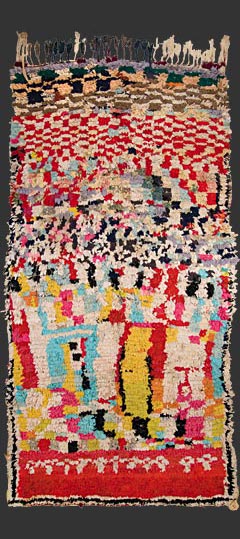 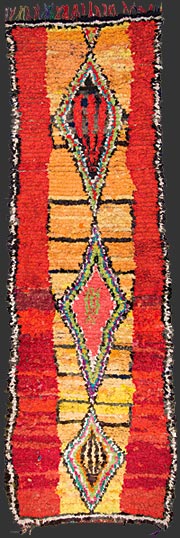 |
| boucherouite, 275 x 145 cm (9' 2'' x 4' 10'') boucherouite, 330 x 100 cm (11' x 3' 4'') |
|
The abstractions embody the creative matrixial potential, the tension between being and non-being, becoming. This is, then, a highly energetic, processual, dynamic order, beyond the opposition of being and non-being. These abstractions in both the ‘masculine’ and the ‘feminine’ artistic media are not subject to the law of symbolic substitution: these forms are not signifiers or symbols, referring to a signified object. They therefore do not correspond to a ‘phallocentric’ creation of meaning, and cannot be ‘read’ through any iconology. They are eruptions from the sub-symbolic matrix. This is not to be equated with the ‘female’: the matrix is accessible to both genders, albeit it that on the male side more space is given to phallic figuration (into which, furthermore, matrixial meanings irresistibly continue to intrude). These abstractions belong to an aesthetic energetics, expressing not verbal ideas or feelings, but fundamental and affect-laden experiences of the psycho-corporeal Self or collectivity. |
| Paul Vandenbroeck (* 1953) has a Ph.D. in art history. His research, swerving in a borderzone between art history and cultural anthropology, is on the genesis and transfer of meaning in art, be it figurative (16th-century Flemish painting) or abstract (weaving, performance, painting). He also has studied early modern genre art and it's role, issues of cultural/artistic syncretism, women's artistic interests (e.g. religious art in convents and beguinages), religious art and the perception of the body, trance performances and art, and 'matrixial' approaches to significance. Together with choreographer, dancer and visual artist Pé Vermeersch, he currently prepares a danced exhibition on the energetics of art, which will take place in spring 2012 in Lille's Palais des Beaux-Arts. Paul Vandenbroeck is a researcher at the Royal Museum of Fine Arts at Antwerp and part-time professor at IMMRC, Faculty of Social Sciences, KULeuven. |
|
1 KMSKAntwerpen / IMMRC-KULeuven / Radical HeArts asbl 2 Paul VANDENBROECK, Azetta. Berbervrouwen en hun kunst, Brussels and Ghent, Vereniging voor Tentoonstellingen ‘Paleis voor Schone Kunsten’ and Ludion, 2000 [Published in French as: Azetta. L’art des femmes berbères, Ghent and Paris, Ludion/Flammarion, 2000], p. 165; a closely related 19th-century Caucasian kilim bears the same scheme, but with ‘regularized’ execution (Hali, no. 69, 1993, pp. 60-61, and Hali, no. 70, 1993, p. 132). See also : Paul VANDENBROECK, “The Energetics of an Unknowable Body: The Sacred and the Aniconic-Sublime in Early Modern Religious Culture”, in Backlit Heaven: Power and Devotion in the Archdiocese of Mechelen, Tielt, Lannoo, 2009, pp. 174-205. 3 Tunis, Bardo Museum, room XXIII, unnumbered. 4 These ‘lightning’ weaves have counterparts in the jeweller’s art. Some fibulae are decorated with zigzags, ‘rain’ spots, holes and triangles: symbols of fertility/fertilization. Bert FLINT, Formes et symboles dans les arts maghrébins I, Bijoux, amulettes, n.p., 1973, no. 21 (Ait Seghrouchen). Potters from Kabylie applied the same decoration (zigzags, spots, ‘holes’, oscillating lines) to enormous storage pots (ikoufan) that were imagined as ‘women’ without there being any comparison to human forms. The body of the ‘storage woman’ bears the same signs as the aforementioned fibulae. F.-E. ROUBET, “À propos du décor chiromorphe d’une poterie kabyle”, Libyca anthropologica 13 (1965), pp. 287-309, fig. 8. 5 Cecile DULIÉRE et al., Utique. Les mosaïques in situ en dehors des insulae I-II-III, Tunis, 1974, pl. XXX. 6 Id., op.cit., pl. XL (no. 218) & XLV (no. 238). 7 Id., op.cit., pl. XLI & XLIII (no. 227). 8 Id., op.cit., pl. XLIII (no. 225). 9 W. HILDBURGH, “Indeterminability and Confusion as Apotropaic Elements in Italy and Spain”,Folklore (London) 55 (1944), pp. 133-149, esp. pp. 139ff and 143. 10 C. LELAND, Etruscan-Roman Remains in Popular Tradition, London, 1892, pp. 168ff. 11 W. MATTHEWS, Mazes and Labyrinths, London, 1922. 12 W. HILDBURGH, “The place of confusion and indeterminability in mazes and maze-dances”, Folklore (London) 56 (1946), pp. 188-192. 13 The net was also the sign of the amniotic membrane, or caul. 14 Here there is notable importance attached to the colours purple and violet. See Alfred & Suzanne SAULNIERS, Aït Bou Ichaouen: Weavings of a Nomadic Berber Tribe, Tucson AR, Fenestra Books, 2003. 15 Hélène GENEVOIS, La terre pour les Kabyles: ses bienfaits, ses mystères, (Fichiers de documentation berbère, no. 113), Larba‘a N‘ath Iraten (ex-Fort-National), 1972. 16 Stefania PANDOLFO, “Detours of Life: Space and Bodies in a Moroccan Village”, American Ethnologist 16, 1989, pp. 3-23. 17 Kamal NAÏT-ZERRAD, Dictionnaire des racines berbères (formes attestées). I. A-BcZL, Paris and Leuven, Peeters, 1998, p. 59. 18 NAÏT-ZERRAD 1998, op.cit., pp. 25-29. 19 M. STOL, Zwangerschap en geboorte bij de Babyloniërs en in de Bijbel, Leiden, Ex Oriente Lux, 1983, p. 7. For the European tradition, see Carlo GINZBURG, The Cheese and the Worms: The Cosmos of a Sixteenth Century Miller, Baltimore, Johns Hopkins University Press, 1980. 20 Henri JAHIER & Noureddine ABDELKADER, Le livre de la génération du foetus et le traitement des femmes enceintes et de nouveau-nés, Algiers, 1956. 21 Cf. J. RUDHART, Le thème de l’eau primordiale dans la mythologie grecque, Bern, 1971; R. MUTH, Träger der Lebenskraft: Ausscheidungen des Organismus im Volksglauben der Antike, Wien, 1954. 22 R. KRUK, “A Frothy Bubble: Spontaneous Generation in the Medieval Islamic Tradition”, Journal of Semitic studies 35, 1990. 23 The current debate concerning the wearing of headscarves by Muslim women in Western cultures therefore never touches the heart of the issue. For Muslims the deepest reason, in so far as it can be ascertained at all, is unsayable, never mind debatable, in public fora. It would be an assault on womanly horma. So instead reference is made to religious prescript or social categories (such as the ‘protection’ of, or ‘respect’ for the woman). The Western side sees only the gender-political aspect (‘oppression’) or blind acceptance for the sake of ‘respecting the (culture of the) other’. We should not forget that in much of northern Europe no respectable working-class woman would, until recently, have gone outside without a headscarf. That too was not something one discussed. The custom began to disappear in the 1970s, with the cult of ‘modern’ sexualization and female availability. Social space was no longer permitted areas of unutterable feminine secrecy. 24 See Françoise HÉRITIER, Stérilité, aridité, sécheresse: quelques invariants de la pensée symbolique, in Le sens du mal: anthropologie, sociologie, histoire de la maladie, Paris, EAC, 1984. 25 PANDOLFO, art.cit., p. 13. 26 In Islamic art such configurations appear earlier and on a smaller scale on ceramics, such as those produced in Nishapur (11th to 13th centuries). 27An old term, used, for instance, in Islamic cosmogony to designate creative in-between spaces, as in Ibn ‘Arabi’s Sajjara-el-kawn’ or ‘cosmic tree’. 28 Ugur DERMAN, Calligraphies ottomanes. Collection du Musée Sakip Sabanci, Université Sabanci, Istanbul, Paris, RMN, 2000, p. 46-48, no. 1 (Istanbul, ca. 1500); pp. 82-83, no. 19 (1727); pp. 110-111, no. 33 (early 19th century); pp. 122-123, no. 39 (1859); pp. 152-153, no. 54 (1905); pp. 158-159, no. 57 (ca. 1900); and especially pp. 162-165, no. 59 (1932). 29Calligraphie islamique d’après la collection de la Fondation Omar Benjelloun, Casablanca, Éditions Oum, 2000, p. 89 (Mughal style, 17th century); pp. 96-97; p. 105 (Iran, 19th century); p. 107. 30Aardse schoonheid, hemelse kunst. Kunst van de Islam, exh. cat., Amsterdam, Nieuwe Kerk, 1999, pp. 82-83, no. 18A. |
 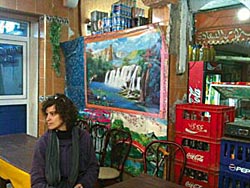 |
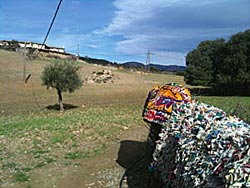 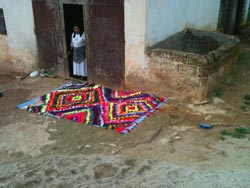 |
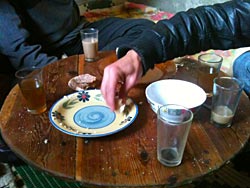 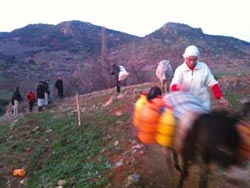 |
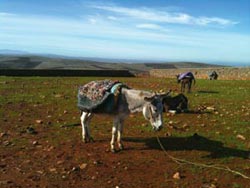 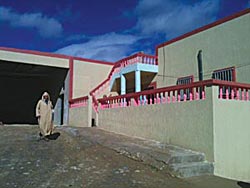 |
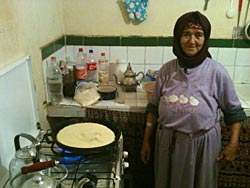 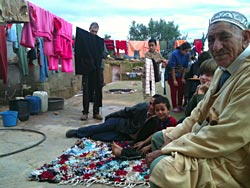 |
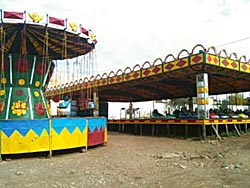 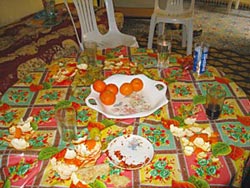 |
|
Boucherouite: Intimations of the Numinous Hand of Nature Randall MORRIS |
|
I. The anthropologist Wade Davis calls the cultural planet we live on the 'Ethnosphere'. He also tells us how every day we are losing the original languages of the peoples that make up this Ethnosphere. This is a harsh and tragic fact. |
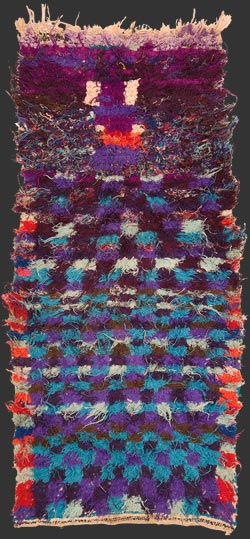 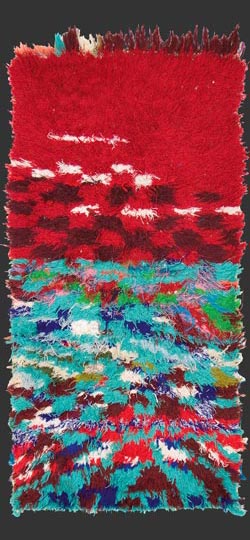 |
| boucherouite, 170 x 80 cm (5' 8'' x 2' 8'') boucherouite, 150 x 100 cm (5' x 2' 8'') |
| We must contend with the historical reality of what Moroccan history has been in the twentieth century. Much of the life of the Amazigh today is a response to French colonialism. Morocco has not been frozen in an Orientalist vision of Western standards of authenticity. The Amazigh (Berber) people have to a large extent remained independent of the Arab culture, they have maintained their own language. In this case the mountain did not go to Mohammed. The heart of this resistance and retention has not been in the area of traditions so much as in identities, and Amazigh women still are the foundation of that cultural identity. For any number of reasons women have been the center of the language, the imagery, the rhythms of the life despite uprootings, despite urbanization, despite colonialism. We can give tangible reasons why these rugs look the way they do. It's simple really. One of the immediate results of the social changes affecting the nomads was scarcity of wool, and this became a regular reality in the 80's. Wool had a spiritual significance, it charged the loom with magic and power. The actuality of this scarcity was that sometimes older rugs were unraveled and recycled. Recycling was already part of the process and culture of rugmaking. When wool became even more expensive and scarce women unraveled clothes that most often were made of synthetic fibers, which hold color in a different way than does wool. The intensity of these colors have become desirable powers of their own. The designs used in the rugs replicate forms used in jewelry and tattoos, even when tattooing had begun to disappear due to the increasing urbanization of the population. These motifs have a fluid history. The triangle is a basic shape, and is known throughout the world as alluding to fertility. But over generations the names for these motifs have changed, and the versatility of the triangle's geometry has allowed it to become houses, pubises, tents, mirrors or eyes. Doubled it becomes a diamond shape, connected they become zigzags that are variously called sickles, scissors, saws. Overlapping triangles have been called spiders. But these names are not constant anymore. Politics changes the language of culture when it can't change the content. Of particular interest to me as well are what some scholars point out in the rugs as markers of landscapes, both tribal and personal. This is in keeping with textiles around the world. Before the French colonialism movement was unrestricted, after it became contained increasingly till the norm was confined. The meaning of the triangles is synchronistic with changing lifestyles and tradition. Carpets are made for home use and are seen as a means of indicating a woman's skill, versatility and her value. Textiles carry valences of fertility. Metaphor and hidden meanings are intrinsic parts of storytelling. Wool was so important when it was accessible that it became a metaphor for spiritual force itself. It is symbolic of the benevolent functioning of nature, wool happens because God gives rain, wool is the end result of God's fecundating Nature. This is why recycling has always been more significant than merely fulfilling an economic function. The power inherent in wool gives the act of weaving a ritualistic aspect. Once the warp threads are attached the textile is born and gains a soul. It moves through the phases of life during the weaving process. The home with a loom in it is the woman's arena of power. When the piece is cut from the loom it is blessed with water as if it is a funeral rite. Woman's conservative place within this cycle of life helps her maintain and conserve the culture within herself. II. It is one thing to look at an Amazigh rug and say it looks like a landscape and another to understand what that landscape really means. We are familiar with the Aboriginal Songlines and their ways of describing space. We know the way that the endless peregrinations of the Yaqui and Mayo peoples in Sonora Mexico during Easter celebrations weave a conceptual border around ancestral grounds that imply and point out the physical merging of place and culture even if it is now under a Freeway. We have seen the knotted quipas from Peru that enigmatically encrypt time and space into an organized language. The tribal peoples of Southern China, Thailand, Laos, Vietnam and Burma have a similar encryptation of place in their textiles. What does this do, this keeping of symbol, this marking out of territory, this vital mapping and charting of a people that fights encroachment on a daily basis? It argues against the theory that women occupy an inferior cultural role. Women are the record-keepers of the culture, weaving historical scrolls and maps into textiles, rendering space into geometric patterns. Additionally this also maps migrations. And today, this is important in a time when nomadic groups have stopped their peripatetic movements and settled within a larger and more impersonal landscape. In just this aspect one can see that not only does a woman make history but she also can turn that history into a symbolic language, thereby abstracting it. Then it is not hard to see how this would translate into the rugs. The rugs are the language of a people regrouping, They are indicators of flux, chaos and order. The visual systems come together, break down, and come together again. But the culture is still there though perhaps with new accents. Opposing colors that are meaningful to the group are still laid side by side in traditional ways. The personal meanings of the rugs, the links with fertility etc still have a numinous presence since they packed with the spiritual abstractions of sperm, birth, rites of passage and death. Even the loosest ones reverberate with earth songs. There can be little continuous rhythm in the real visual world. The cacophony blends into a cohesive whole consisting of disparate sounds just like a John Zorn horn line. If accident is part of process then it is no accident, it is improvisation in the language of the artist, a seizing of opportunity here and now using a known mode of communication. There are very few indigenous people in the world that do not recycle the world in some form. Apart from those named above, another example that comes to mind is the yard shows of the African-American diaspora in which cast-off objects from everyday life are arranged in personal spaces throughout the American South in a way that seems random and inscrutable to outsiders but is immediately accepted and understood within that culture. These yard shows contain, in symbolic form, family history, homage to ancestors, references to the world of the dead, ethical living, color codes, symbolic shapes, personal teachings and manifestations of personal creativity and prowess. It is interesting that it is mostly women who keep and sweep these yards. III. I feel this is the golden moment for connoisseurship of these rugs. As life changes, the meaning of time in these women's lives will pick up a different cadence and as the need for financial survival increases, less time can be spent on personal pursuits. These rugs were made for the internal heart of their culture, and that heart is beating and in the flux of change. In the future something will shift and displace the focus that they presently give these artworks. Something no less integral. Something always does. It will not be inferior, but it will be different. |
| Randall Morris (* 1953) is a writer, curator + co-owner of Cavin Morris gallery . Currently working on two projects: Indigenous Drawing + redemption Songs: The Self-Taught Artists of Jamaica. |
|
|
| variant spellings: boucharouette, boucherouite, bouchraouit, boucharouit, boucharouite, boucherwit, bou sherwit, bu sherwit, bouchrawit, boucharwit |
| please view a fine selection of boucherouite rag rugs in the 'carpets' section of the website |
|
The catalogue 'Post Punk Pink' in which these articles have originally been published is available on the 'BOOKS + CATALOGUES' page. Gebhart Blazek (ed.), Miriam Ali de Unzaga, Paul Vandenbroeck, Randall Morris: 'Post Punk Pink', exhibition catalogue Graz, 2010. 112 pages, 90 full page colour plates + 19 colour photos, English, soft cover. Euro 35,00 + shipping costs |
|
all carpet photos by Gebhart Blazek, additional photography by Miriam Ali de Unzaga, Julius Steinhauser, Maximilian Reumueller + Gebhart Blazek all copyrights © GEBHART BLAZEK, 2010 |




